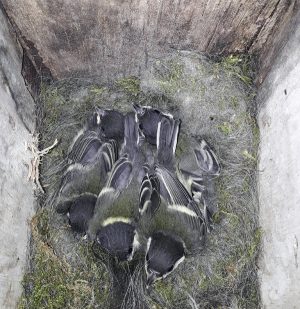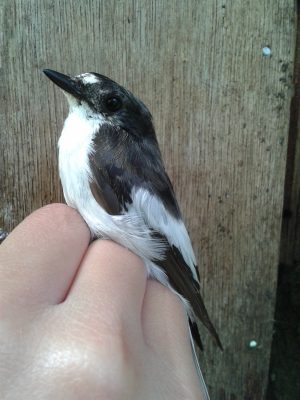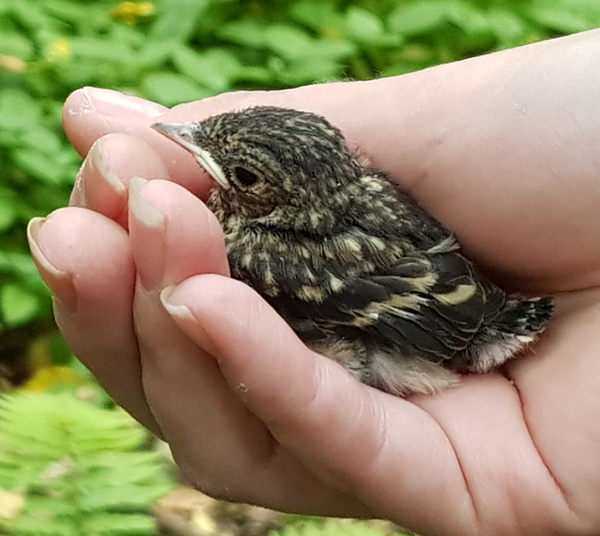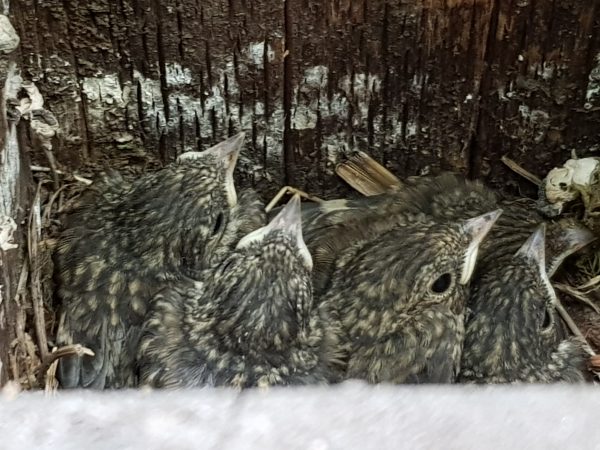Woodland bird monitoring

Each of our team members looks after a number of woodland sites across the UK, and recently we were contacted regarding one of our latest additions to the Woodlands.co.uk portfolio, Coed Craig-y-Pandy, aka Pandy Wood, near Llangollen in North Wales, by someone known locally as Nicky ‘the bird lady’. Apparently this site has been part of a long term scheme of monitoring nesting birds and nest boxes, and we were being asked permission for this to continue.
Myself (Chris) and local area manager Jon went to meet Nicky one afternoon to find out more of what she does and how it benefits our local birdlife. We were given a tour of the nest boxes in the woodland – most of which were empty as the young birds had already fledged - but we were treated to a look inside a couple of boxes where the chicks were still being fed. Nicky explained that the birds we were looking at were close to fledging themselves, and that she would be back to check the boxes again to see what happened. Below are some photos of the baby birds we saw.
Nicky also showed us that she had ringed the birds in the nests, and explained that in future should these birds be found again we would know how long they had lived for and where they had come from by using the unique number on the ring to identify them. This is a way of monitoring bird populations, and as many species have suffered significant declines in recent years it is important to know what is happening to our wildlife, and how they are affected by habitat losses, pollution, changes to farming practices and climate for example.

Below Nicky explains in her own words what she does and what has been happening in the woodland this year:
"My name is Nicky, though I am known to the locals as ‘the bird lady’, and I am a registered nest recorder and licensed bird ringer with the British Trust for Ornithology (BTO). I first started visiting the valley of Glyn Ceiriog in 2001 with a chap called Andy, who back then was of course known as ‘the bird man’, and I took over monitoring the area in 2005. There were only two nest boxes in Pandy wood at first, but I have since increased the number to over 40. In total I have around 150 boxes or more that I monitor in the valley, but I also spend a large amount of time looking at other, non-nest box using bird species as well.
The main species of interest in the nest boxes is the pied flycatcher, which is a small, migratory songbird that over winters in sub-Saharan Africa. This year there have been five pairs using the boxes in Pandy wood, which is quite a good number considering that valley-wide their numbers are down (and only 17 pairs in total using my boxes), and between them they have hatched 32 chicks which should all have fledged by mid June. There were also four blue tit and four great tit nests in the boxes in Pandy wood. The blue tits have been having a good year, after recent bad years, and have raised 26 chicks in Pandy wood, but the great tits are down in number this year after having several boom years, and have only managed 14 chicks as two of their nests failed.
 On my visits I monitor the nests as they progress so determine how successful they are. I record information on
On my visits I monitor the nests as they progress so determine how successful they are. I record information on
- nest building stages,
- egg laying and incubation,
- the development of the chicks, and
- the outcome of the nest.
All of this information is recorded on nest record cards (which used to actually be cards, but now they are mostly digital) and sent off to the BTO at the end of the season, who use it for population monitoring. I take note of any natural nests I find as well as nest boxes, so I spend a lot of time in the valley looking for nests, or going to places that have nests every year (e.g. dippers on the river, jackdaws, swallows and house sparrows in farm buildings). I have not noticed any natural nests in Pandy wood this year, although I did hear a male wood warbler (another uncommon, migratory songbird) singing, indicating he may have had a nest nearby.
As I am also a licensed bird ringer, when the chicks are big enough I add a metal ring to their legs with a unique number on it. If the bird is caught again or found dead, a record is generated of how long it lived and where it travelled to after it fledged. All the ringing data is also submitted to the BTO.
I also trap the adult pied flycatchers, and I have had some very interesting finds from doing so. This year I trapped a male bird that I have caught every single year (though at a different nest box each time) since he was ringed as a chick in 2013. Another year, I had a female originally from Northumberland. I caught her several years in a row, until one particularly cold, wet spring when I found her dead on her nest. I have had a female from the valley breed the following year in Cornwall, and one year I had a male bird attending two separate boxes - one in Pandy wood, the other over 600m away in fields by the river. This happened again another year more recently, but the two boxes were much closer together.

Pied Flycatcher - about 10 days old
All of my observations and data is sent initially to Merseyside Ringing Group (MRG), who then sends all of our group’s data to the BTO. Despite its name our group actually covers quite a large area, including Wirral, Cheshire and North Wales."
More information on Merseyside Ringing Group, and the BTO’s nest recording and ringing schemes, can be found at the following links:
- https://www.bto.org/volunteer-surveys/nrs
- https://www.bto.org/volunteer-surveys/ringing
- http://www.merseysiderg.org.uk/
"At the end of the season the nest boxes are cleaned out for next year, and any boxes that need repairing or replacing are done so over the winter. As it has been over 10 years since many of the nest boxes were installed in Pandy wood, I anticipate a busy winter this year making more boxes!"

Pied Flycatcher young in the nest box
Comments are closed for this post.
